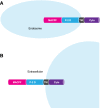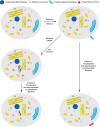Perforin-2/Mpeg1 and other pore-forming proteins throughout evolution
- PMID: 26307549
- PMCID: PMC4600061
- DOI: 10.1189/jlb.4MR1114-523RR
Perforin-2/Mpeg1 and other pore-forming proteins throughout evolution
Abstract
Development of the ancient innate immune system required not only a mechanism to recognize foreign organisms from self but also to destroy them. Pore-forming proteins containing the membrane attack complex Perforin domain were one of the first triumphs of an innate immune system needing to eliminate microbes and virally infected cells. Membrane attack complex of complement and Perforin domain proteins is unique from other immune effector molecules in that the mechanism of attack is strictly physical and unspecific. The large water-filled holes created by membrane attack complex of complement and Perforin domain pore formation allow access for additional effectors to complete the destruction of the foreign organism via chemical or enzymatic attack. Perforin-2/macrophage-expressed protein 1 is one of the oldest membrane attack complexes of complement and Perforin domain protein involved in immune defense, and it is still functional today in vertebrates. Here, we trace the impact of Perforin-2/macrophage-expressed protein 1 from the earliest multicellular organisms to modern vertebrates, as well as review the development of other membrane attack complexes of complement and Perforin domain member proteins.
Keywords: MACPF; bacteria; complement.
© Society for Leukocyte Biology.
Figures





Similar articles
-
Breaching the Bacterial Envelope: The Pivotal Role of Perforin-2 (MPEG1) Within Phagocytes.Front Immunol. 2021 Feb 22;12:597951. doi: 10.3389/fimmu.2021.597951. eCollection 2021. Front Immunol. 2021. PMID: 33692780 Free PMC article. Review.
-
Cholesterol-dependent cytolysins.Adv Exp Med Biol. 2010;677:56-66. doi: 10.1007/978-1-4419-6327-7_5. Adv Exp Med Biol. 2010. PMID: 20687480 Review.
-
Killing machines: three pore-forming proteins of the immune system.Immunol Res. 2013 Dec;57(1-3):268-78. doi: 10.1007/s12026-013-8469-9. Immunol Res. 2013. PMID: 24293008 Free PMC article. Review.
-
The structure and function of mammalian membrane-attack complex/perforin-like proteins.Tissue Antigens. 2010 Nov;76(5):341-51. doi: 10.1111/j.1399-0039.2010.01566.x. Epub 2010 Sep 22. Tissue Antigens. 2010. PMID: 20860583 Review.
-
Structure of C8alpha-MACPF reveals mechanism of membrane attack in complement immune defense.Science. 2007 Sep 14;317(5844):1552-4. doi: 10.1126/science.1147103. Science. 2007. PMID: 17872444
Cited by
-
Staphylococcus epidermidis Boosts Innate Immune Response by Activation of Gamma Delta T Cells and Induction of Perforin-2 in Human Skin.Front Immunol. 2020 Sep 16;11:550946. doi: 10.3389/fimmu.2020.550946. eCollection 2020. Front Immunol. 2020. PMID: 33042139 Free PMC article.
-
Breaching the Bacterial Envelope: The Pivotal Role of Perforin-2 (MPEG1) Within Phagocytes.Front Immunol. 2021 Feb 22;12:597951. doi: 10.3389/fimmu.2021.597951. eCollection 2021. Front Immunol. 2021. PMID: 33692780 Free PMC article. Review.
-
Knocking 'em Dead: Pore-Forming Proteins in Immune Defense.Annu Rev Immunol. 2020 Apr 26;38:455-485. doi: 10.1146/annurev-immunol-111319-023800. Epub 2020 Jan 31. Annu Rev Immunol. 2020. PMID: 32004099 Free PMC article. Review.
-
Frequent birth-and-death events throughout perforin-1 evolution.BMC Evol Biol. 2020 Oct 19;20(1):135. doi: 10.1186/s12862-020-01698-1. BMC Evol Biol. 2020. PMID: 33076840 Free PMC article.
-
tRNA-like Transcripts from the NEAT1-MALAT1 Genomic Region Critically Influence Human Innate Immunity and Macrophage Functions.Cells. 2022 Dec 8;11(24):3970. doi: 10.3390/cells11243970. Cells. 2022. PMID: 36552736 Free PMC article.
References
-
- Medzhitov R., Janeway C. Jr. (2000) The Toll receptor family and microbial recognition. Trends Microbiol. 8, 452–456. - PubMed
-
- Akira S., Takeda K., Kaisho T. (2001) Toll-like receptors: critical proteins linking innate and acquired immunity. Nat. Immunol. 2, 675–680. - PubMed
-
- Janeway C. A. Jr., Medzhitov R. (2002) Innate immune recognition. Annu. Rev. Immunol. 20, 197–216. - PubMed
-
- Law R. H., Lukoyanova N., Voskoboinik I., Caradoc-Davies T. T., Baran K., Dunstone M. A., D’Angelo M. E., Orlova E. V., Coulibaly F., Verschoor S., Browne K. A., Ciccone A., Kuiper M. J., Bird P. I., Trapani J. A., Saibil H. R., Whisstock J. C. (2010) The structural basis for membrane binding and pore formation by lymphocyte perforin. Nature 468, 447–451. - PubMed
-
- Kondos S. C., Hatfaludi T., Voskoboinik I., Trapani J. A., Law R. H., Whisstock J. C., Dunstone M. A. (2010) The structure and function of mammalian membrane-attack complex/perforin-like proteins. Tissue Antigens 76, 341–351. - PubMed
Publication types
MeSH terms
Substances
Grants and funding
LinkOut - more resources
Full Text Sources
Other Literature Sources
Molecular Biology Databases
Research Materials

